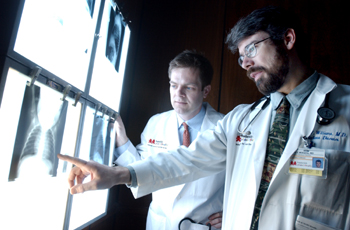
Dr. James Crowe, left, and Dr. John V. Williams look at chest X-rays of infants with the MPV infection. These images were used in their study published this week in the New England Journal of Medicine. Photo by Dana Johnson
Research describes major cause of infant pneumonia
Researchers at Vanderbilt Children’s Hospital have nailed down a clear picture of a newly described virus that is a leading cause of pneumonia in babies. A study in this week’s New England Journal of Medicine defines the “who, how and how much” of the impact of human metapneumovirus (MPV) on children.
“Our findings show human metapneumovirus is the second most common cause of serious respiratory illness in young children,” said Dr. James E. Crowe, senior author of the article and associate professor of Pediatric Infectious Diseases at Vanderbilt Children’s Hospital. “This appears to be more important than influenza for babies.”
After examining samples and data from more than 2,000 infants and children, seen over the course of 25 years and stored in refrigerators at the Vanderbilt Vaccine Clinic, Crowe and his team found MPV was the apparent cause of up to 12 percent of lower respiratory illness in the first year of life, rivaling the No. 1 culprit, respiratory syncytial virus (RSV).
“It’s amazing to think as pediatricians we’ve been seeing this virus for decades, and now it’s exciting to know what it is,” Crowe said.
“We do see a lot of bronchiolitis, or lower respiratory illness, that doesn’t test positive for viruses,” said lead author, Dr. John V. Williams, assistant professor of Pediatric Infectious Diseases. “That’s why this research is so important, because it gives a name and description to a lot of serious infections.”
Of the 2,000 children in the study, 321 had symptoms of lower respiratory tract illness, including pneumonia, for which no viral agent could be identified; but 20 percent of those samples tested positive for MPV, which meant that 12 percent of all wheezing and pneumonia in the clinic was due to MPV.
“That was surprising to find that one virus was the cause of such a large proportion of disease that previously tested negative for anything else,” Williams said.
The study supports previous findings that the leading cause of lower respiratory infection in infants is RSV. Fifteen percent of children in this study with lower respiratory illness tested positive for RSV. Parainfluenza accounted for 10 percent of the infections; influenza accounted for 5 percent and adenovirus 4 percent.
“This study goes beyond just defining the scope of the problem. It gives us the first good clinical definition of MPV,” Williams said. “We now know it is most severe in children younger than 1 year old. We know that in two-thirds of cases it causes bronchiolitis; 10 percent will get pneumonia; 20 percent croup; and 14 percent of these children were diagnosed with an asthma exacerbation.”
The asthma connection is one element of the study results that will likely be scrutinized in further studies.
“One of the intriguing things we found in this study is that MPV is three times more likely to trigger an asthma attack than RSV or similar viruses,” Williams said. “We’re not sure what it means, but the association is robust and we believe will be duplicated in more studies.”
Williams says funding for studies to find preventions or treatments for MPV will come quickly because this study suggests this illness is quite costly to society; he has two NIH-funded grants to study the virus.
“It is a major cause of ear infection,” Williams said. “Forty percent of children in this study with MPV also had ear infections.”
Hospitalization rates for infants were similar to the rates for RSV, but more spread out throughout the year, while RSV normally peaks in January.
“This study told us what we can expect MPV to do to healthy kids, the next step is to find out how serious the most severe cases can be,” Williams said. “We’re currently conducting studies at VCH to see what MPV does to children with a depressed immune system, like cancer or transplant patients, or to children already in the intensive care units either because of prematurity, or other medical issues.”
“This virus was only discovered by a virus hunter in the Netherlands about two years ago,” Crowe said. “And already we have been able to define its clinical effects. The only virus that has moved more quickly through research is the SARS virus.”
Crowe says the National Institutes of Health is already funding studies to develop candidate vaccines. Crowe, himself, has funding from a drug company to look at an animal model to develop a vaccine.
“This virus is a good candidate for quick development of a monoclonal antibody, much like the Synagis antibody for RSV,” Crowe said. “That’s the kind of drug that could be given to babies and children at the very highest risk for MPV, like premature babies and cancer patients.”
One of the major drawbacks right now is the lack of a standardized test.
“The test we used is a good one, but is hasn’t been through the required standardization so that physicians can use it in their day-to-day operations. We may still be two years from that,” Crowe said.
While the public waits for tests, preventions and treatments for the human metapneumovirus, there are some common-sense things parents can use to protect themselves and their infants from this common cause of pneumonia.
“Given what we know from related viruses, we can suggest that MPV is probably spread through nasal secretions,” said Crowe. “Good hand washing is the best prevention.”













